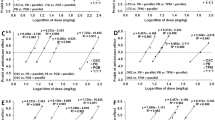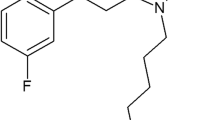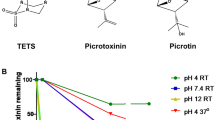Abstract
The aim of this study was to characterize the interaction between tiagabine (TGB) and ethosuximide (ETS), two antiepileptic drugs, in pentylenetetrazole (PTZ)-induced clonic seizures in mice using isobolographic analysis. The nature of the interaction between the drugs administered in combination was ascertained by estimating plasma and brain concentrations of ETS and TGB using fluorescence polarization immunoassay (FPIA) and high-performance liquid chromatography (HPLC). The results indicated that both drugs produced clear anticonvulsant effects against PTZ-induced clonic seizures in mice, but that their dose-response relationship curves (DRRCs) were not parallel, consequently necessitating the isobolographic analysis for non-parallel DRRCs. The isobolographic analysis revealed that the combination of TGB with ETS at the fixed-ratio of 1:1 exerted an additive interaction against PTZ-induced clonic seizures in mice. FPIA documented that TGB significantly elevated brain ETS concentrations (by 64%), while having no effect on plasma ETS concentrations in experimental animals. In contrast, ETS had no significant impact on plasma and brain concentrations of TGB in mice, as measured by HPLC. It can be concluded that the additive interaction between TGB and ETS at the fixed-ratio of 1:1 in the PTZ test was complicated by a significant pharmacokinetic increase in total brain ETS concentrations. At present, there are no recommendations to use this drug combination in epileptic patients.


Similar content being viewed by others
References
Berenbaum MC (1989) What is synergy? Pharmacol Rev 41:93–141 Erratum published in (1989) Pharmacol Rev 41:422
Boissier JR, Tardy J, Diverres JC (1960) Une nouvelle methode simple pour explorer l’action «tranquilisante»: le test de la cheminee. Med Exp (Basel) 3:81–84
Brodie MJ, Schachter SC (2001) Fast Facts. Epilepsy, 2nd edn. Health Press, Oxford
Cadart M, Marchand S, Pariat C, Bouquet S, Couet W (2002) Ignoring pharmacokinetics may lead to isoboles misinterpretation: illustration with the norfloxacin-theophylline convulsant interaction in rats. Pharm Res 19:209–214
Deckers CLP, Czuczwar SJ, Hekster YA, Keyser A, Kubova H, Meinardi H, Patsalos P, Renier WO, van Rijn CM (2000) Selection of antiepileptic drug polytherapy based on mechanism of action: the evidence reviewed. Epilepsia 41:1364–1374
Grabovsky Y, Tallarida RJ (2004) Isobolographic analysis for combinations of a full and partial agonist: curved isoboles. J Pharmacol Exp Ther 310:981–986
Greco WR, Bravo G, Parsons JC (1995) The search for synergy: a critical review from response surface perspective. Pharmacol Rev 47:331–385
Leach JP (2000) Antiepileptic drugs: safety in numbers. Seizure 9:170–178
Leppik IE (2001) Contemporary diagnosis and management of the patients with epilepsy, 5th edn. Handbooks in health care. Newtown, Pennsylvania
Litchfield JT, Wilcoxon F (1949) A simplified method of evaluating dose-effect experiments. J Pharmacol Exp Ther 96:99–113
Loewe S (1953) The problem of synergism and antagonism of combined drugs. Arzneimittelforschung 3:285–290
Löscher W, Schmidt D (1988) Which animal models should be used in the search for new antiepileptic drugs? A proposal based on experimental and clinical considerations. Epilepsy Res 2:145–181
Löscher W, Wauquier A (1996) Use of animal models in developing guiding principles for polypharmacy in epilepsy. Epilepsy Res Suppl 11:61–65
Löscher W, Hönack D, Fassbender CP, Nolting B (1991) The role of technical, biological and pharmacological factors in the laboratory evaluation of anticonvulsant drugs. III. Pentylenetetrazole seizure models. Epilepsy Res 8:171–189
Luszczki JJ (2007) Isobolographic analysis of interaction between drugs with nonparallel dose-response relationship curves: a practical application. Naunyn Schmiedebergs Arch Pharmacol 375:105–114
Luszczki JJ, Czuczwar SJ (2003) Isobolographic and subthreshold methods in the detection of interactions between oxcarbazepine and conventional antiepileptics-a comparative study. Epilepsy Res 56:27–42
Luszczki JJ, Czuczwar SJ (2004) Isobolographic profile of interactions between tiagabine and gabapentin: a preclinical study. Naunyn Schmiedebergs Arch Pharmacol 369:434–446
Luszczki JJ, Czuczwar SJ (2005) Isobolographic characterisation of interactions among selected newer antiepileptic drugs in the mouse pentylenetetrazole-induced seizure model. Naunyn Schmiedebergs Arch Pharmacol 372:41–54
Luszczki JJ, Czuczwar SJ (2006) Biphasic characteristic of interactions between stiripentol and carbamazepine in the mouse maximal electroshock-induced seizure model: a three-dimensional isobolographic analysis. Naunyn Schmiedebergs Arch Pharmacol 374:51–64
Luszczki JJ, Czuczwar SJ (2007) Isobolographic characterization of interactions between vigabatrin and tiagabine in two experimental models of epilepsy. Prog Neuropsychopharmacol Biol Psychiatry 31:529–538
Luszczki JJ, Swiader M, Parada-Turska J, Czuczwar SJ (2003a) Tiagabine synergistically interacts with gabapentin in the electroconvulsive threshold test in mice. Neuropsychopharmacology 28:1817–1830
Luszczki JJ, Swiader M, Czuczwar M, Kis J, Czuczwar SJ (2003b) Interactions of tiagabine with some antiepileptics in the maximal electroshock in mice. Pharmacol Biochem Behav 75:319–327
Luszczki JJ, Wojcik-Cwikla J, Andres MM, Czuczwar SJ (2005) Pharmacological and behavioral characteristics of interactions between vigabatrin and conventional antiepileptic drugs in pentylenetetrazole-induced seizures in mice: an isobolographic analysis. Neuropsychopharmacology 30:958–973
Luszczki JJ, Ratnaraj N, Patsalos PN, Czuczwar SJ (2006) Isobolographic analysis of interactions between loreclezole and conventional antiepileptic drugs in the mouse maximal electroshock-induced seizure model. Naunyn Schmiedebergs Arch Pharmacol 373:169–181
Meyer OA, Tilson HA, Byrd WC, Riley MT (1979) A method for the routine assessment of fore- and hindlimb grip strength of rats and mice. Neurobehav Toxicol 1:233–236
Porreca F, Jiang Q, Tallarida RJ (1990) Modulation of morphine antinociception by peripheral [Leu5]enkephalin: a synergistic interaction. Eur J Pharmacol 179:463–468
Tallarida RJ (2000) Drug synergism and dose-effect data analysis. Chapman and Hall/CRC, Boca Raton,
Tallarida RJ (2006) An overview of drug combination analysis with isobolograms. J Pharmacol Exp Ther 319:1–7
Tallarida RJ (2007) Interactions between drugs and occupied receptors. Pharmacol Ther 113:197–209
Venault P, Chapouthier G, de Carvalho LP, Simiand J, Morre M, Dodd RH, Rossier J (1986) Benzodiazepine impairs and beta-carboline enhances performance in learning and memory tasks. Nature 321:864–866
Acknowledgements
This study was supported by a grant (DS 345/2003–2005) from the Medical University of Lublin. The author expresses his thanks to Dr. G. Raszewski (Institute of Agricultural Medicine, Lublin, Poland) for the skilful determination of the plasma and brain concentrations of tiagabine with HPLC.
Author information
Authors and Affiliations
Corresponding author
Rights and permissions
About this article
Cite this article
Luszczki, J.J. Interactions of tiagabine with ethosuximide in the mouse pentylenetetrazole-induced seizure model: an isobolographic analysis for non-parallel dose-response relationship curves. Naunyn-Schmied Arch Pharmacol 378, 483–492 (2008). https://doi.org/10.1007/s00210-008-0305-8
Received:
Accepted:
Published:
Issue Date:
DOI: https://doi.org/10.1007/s00210-008-0305-8




